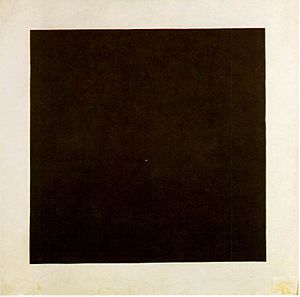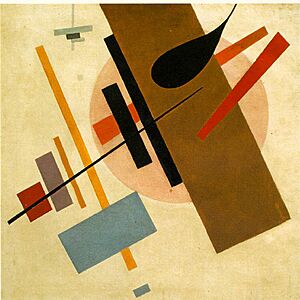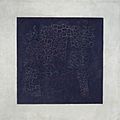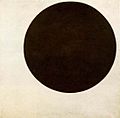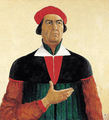Suprematism facts for kids
Suprematism is a type of abstract art that began in Russia around 1915. It focuses on very simple geometric shapes like the square and circle. It's a great example of art made from basic shapes.
The artist Kazimir Malevich started Suprematism. He wrote a book called The Non-Objective World. In it, he explained how he got the idea for his famous painting, the Black Square:
- I felt only night within me and it was then that I conceived the new art, which I called Suprematism.
Malevich created a "grammar" for Suprematism using basic shapes. The square and circle were especially important. In 1915, he showed his first Suprematist paintings. The most important one was the Black Square. He placed it in a special spot in the exhibition, like where an important religious picture would go in a Russian home. This painting was a huge step forward for Malevich and for art in general. He also painted White on White, which was a move from using many colors to just one color in Suprematism.
Some of his painting titles from 1915 show his ideas about shapes moving through time. For example, one title was: Two dimensional painted masses in the state of movement.
Contents
What Was the Supremus Group?
The Supremus group started meeting in 1915. They talked about the ideas behind Suprematism and how it could be used in other parts of life. Some Suprematist artists, like Lyuba Popova and especially El Lissitzky, also worked on propaganda and industrial design. This means they used art to spread messages or design everyday objects.
Lissitzky helped share Suprematist ideas with other countries in the early 1920s.
How Suprematism Influenced Architecture
Artists like Nikolai Suetin used Suprematist designs on items made at the Lomonosov Porcelain Factory in Saint Petersburg. Malevich himself designed a Suprematist teapot. In the 1920s, Suprematist artists also created models for buildings. These designs were different from the buildings made by Constructivist architects.
Malevich's building designs, called Arkhitektoniki, appeared after 1922. They often used right angles, similar to styles like De Stijl and Le Corbusier. These designs were linked to ideas of equality and communist government. Malevich didn't like triangles in his designs. He thought they looked old-fashioned or connected to ancient religions.
Art and Society in Russia
Suprematism grew during a time of big changes in Russia. The country was going through a revolution, and old ways were being replaced by new ideas. But as the new government became stronger, especially under Stalinism from 1924, artists started to lose their freedom.
By the late 1920s, the Russian avant-garde (artists who create new and experimental art) faced strong criticism from the government. In 1934, a new art style called socialist realism became the official art style. This style did not allow abstract art or other new ways of artistic expression.
Images for kids
-
Kazimir Malevich, Black Square, 1915.
-
El Lissitzky, A Proun, around 1925.
See also
 In Spanish: Suprematismo para niños
In Spanish: Suprematismo para niños


